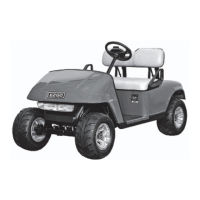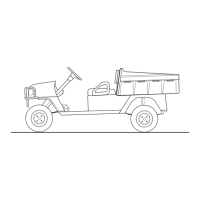SAFETY
Read and understand the following warnings
before attempting to operate the vehicle:
To prevent personal
injury or death, observe
the following:
When vehicle is to be left unattended, engage
parking brake, move direction selector to ‘F’
(forward) position, turn key to ‘OFF’ position and
remove key.
Drive vehicle only as fast as terrain and safety
considerations allow. Consider the terrain and
traffic conditions. Consider environmental
factors which effect the terrain and the ability to
control the vehicle.
Avoid driving fast down hill. Sudden stops or
change of direction may result in a loss of
control. Use service brake to control speed when
traveling down an incline.
Use extra care and reduced speed when driving
on poor surfaces, such as loose dirt, wet grass,
gravel, etc.
All travel should be directly up or down hills.
Use extra care when driving the vehicle across
an incline.
Stay in designated areas and avoid steep slopes.
Use the parking brake whenever the vehicle is
parked.
Keep feet, legs, hands and arms inside vehicle at
all times.
Avoid extremely rough terrain.
Check area behind the vehicle before operating
in reverse.
Make sure the direction selector is in correct
position before attempting to start the vehicle.
Slow down before and during turns. All turns
should be executed at reduced speed.
Always bring vehicle to a complete stop before
shifting the direction selector.
See GENERAL SPECIFICATIONS for vehicle load
and seating capacity.
Read and understand the following text and
warnings before attempting to service vehicle:
In any product, components will eventually fail to perform
properly as the result of normal use, age, wear or abuse.
It is virtually impossible to anticipate all possible compo-
nent failures or the manner in which each component
may fail.
Be aware that a vehicle requiring repair indicates that the
vehicle is no longer functioning as designed and there-
fore should be considered potentially hazardous. Use
extreme care when working on any vehicle. When diag-
nosing, removing or replacing any components that are
not operating correctly, take time to consider the safety of
yourself and others around you should the component
move unexpectedly.
Some components are heavy, spring loaded, highly cor-
rosive, explosive or may produce high amperage or
reach high temperatures. Gasoline, carbon monoxide,
battery acid and hydrogen gas could result in serious
bodily injury to the technician/mechanic and bystanders if
not treated with the utmost caution. Be careful not to
place hands, face, feet or body in a location that could
expose them to injury should an unforeseen situation
occur.
Always use the appropriate tools listed in the tool list and
wear approved safety equipment.
Before working on the
vehicle, remove all
jewelry (rings,
watches, necklaces,
etc.)
Be sure that no loose clothing or hair can contact
moving parts.
Use care not to touch hot objects.
Raise rear of vehicle and support on jack stands
before attempting to run or adjust powertrain.
Wear eye protection when working on or around
vehicle. In particular, use care when working
around batteries, using solvents or compressed
air.
Hydrogen gas is formed when charging
batteries. Do not charge batteries without
adequate ventilation.
Do not permit open flame or anyone to smoke in
an area that is being used for charging batteries.
A concentration of 4% hydrogen gas or more is
explosive.
Engine exhaust gas (carbon monoxide) is
deadly. Carbon monoxide is an odorless,
colorless gas that is formed as a natural part of
incomplete combustion of hydrocarbon fuels.
Carbon monoxide is a dangerous gas that can
cause unconsciousness and is potentially lethal.
The following are symptoms of carbon monoxide
inhalation:
• Dizziness
•Vomiting
• Intense headache
• Muscular twitching
• Weakness and sleepiness
• Throbbing in temples
If any of these symptoms are experienced, get
fresh air immediately. Never work around or
operate a vehicle in an environment that does
not ventilate exhaust gases from the area.

